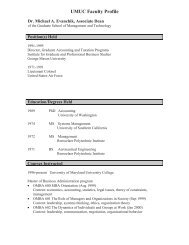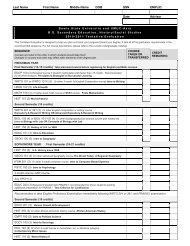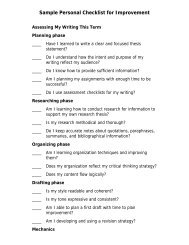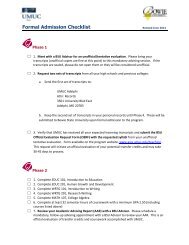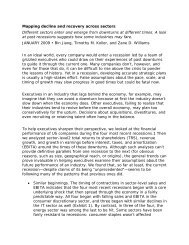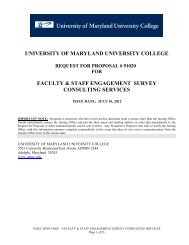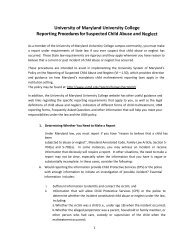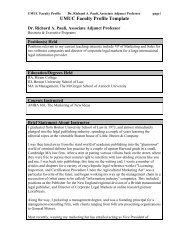A+B. Intro_SJ.1 - University of Maryland University College
A+B. Intro_SJ.1 - University of Maryland University College
A+B. Intro_SJ.1 - University of Maryland University College
You also want an ePaper? Increase the reach of your titles
YUMPU automatically turns print PDFs into web optimized ePapers that Google loves.
XMIT 605 Data Communications and Internet<br />
Technologies (6 )<br />
This seminar begins with a study <strong>of</strong> data communication fundamentals.<br />
These include digital and analog signals; modulation;<br />
circuit and packet switching; multiple access schemes such as<br />
Frequency Division Multiple Access (FDMA), Time Division<br />
Multiple Access (TDMA), and Code Division Multiple Access<br />
(CDMA); and telecommunication standards such as the Open<br />
System Interconnect (OSI) Model. The course then moves to<br />
telecommunications networks with a re v i ew <strong>of</strong> local area netw<br />
o rks (LANs), including topologies, contention access methods,<br />
and internetworking devices such as bridges, routers, and gateways.<br />
Also covered are wide area networks (WANs), i n c l u d i n g<br />
the Public Switched Telephone Ne t w o rk (PSTN); wireless networks<br />
such as cellular, personal communication systems, and<br />
wireless data; the Integrated Services Digital Network (ISDN);<br />
X.25; Frame Relay; and Asynchronous Transfer Mode (ATM).<br />
Finally, we examine the network convergence issue; that is, one<br />
network for data, voice, images, and video. The focus <strong>of</strong> the<br />
seminar then moves to the Internet, addressing both its technological<br />
basis and its applications. Internet technology, including<br />
packet networking, Transmission Control Protocol/Internet<br />
Protocol (TCP/IP), Internet security, Internet 2, and IPv6, are<br />
examined. Internet applications and their evolving use for multimedia<br />
transmission, private and leased service IP networks,<br />
e-commerce, data warehousing, data mining, and policy issues<br />
such as universal service and access are evaluated.<br />
XMIT 606 Systems Engineering and Capstone (6 )<br />
This seminar begins with the study <strong>of</strong> systems engineering as an<br />
i n t e rd i s c i p l i n a ry approach to developing complex systems that satisfy<br />
a client mission in an operational environment. This examination<br />
<strong>of</strong> the systems engineering process places special emphasis on<br />
computers and s<strong>of</strong>tware systems. Included is an ove rv i ew <strong>of</strong> system<br />
t h e o ry and stru c t u res, elements <strong>of</strong> the systems life cycle, risk and<br />
trade-<strong>of</strong>f analyses, modeling and simulation, and the tools needed<br />
to analyze and support the systems process. Case studies from the<br />
information technology (IT) domain are used to illustrate the systems<br />
engineering principles. The capstone integrates and applies<br />
the major concepts presented in all other coursew o rk. Using casew<br />
o rk methods, students identify best practices and appro p r i a t e<br />
technologies to implement effective IT decisions aligned with organizational<br />
goals. St rong emphasis is placed on viewing IT issues in<br />
a context <strong>of</strong> both day-to-day and strategic management decision<br />
making based on applied re s e a rch. Issues include competitive n e s s ,<br />
information arc h i t e c t u re, user needs, process reengineering, va l u e<br />
chain management, collaborative computing, globalization, social<br />
impact, information policy, and ethics. Emerging trends in information<br />
technology are analyzed to understand their potential<br />
effect on the workplace and society.<br />
XTMN 601 Technology Overview and Strategic<br />
Management (6)<br />
This first seminar provides program participants with the know l-<br />
edge, skills, and techniques they need to develop and continuously<br />
e valuate appropriate business technology strategies for their<br />
organizations. This seminar starts with an ove rv i ew <strong>of</strong> technology<br />
management as an academic discipline and a pr<strong>of</strong>essional practice.<br />
This is followed by an introduction to strategic planning as an<br />
integrated part <strong>of</strong> a new technology-based product or service.<br />
The issues <strong>of</strong> competitive strategy, technology based organizations,<br />
and new product launches are presented. The processes <strong>of</strong><br />
e n t re p reneurship and intrapreneurship are discussed from the<br />
standpoint <strong>of</strong> various organizational functions and levels and how<br />
these processes can be promoted through effective strategic management.<br />
Fi n a l l y, using the principles and technology explored in<br />
the first two seminars, program participants will create a business<br />
plan for a new ve n t u re introducing a new technology-based pro d-<br />
uct or service.<br />
| 154 | 2003–2004 Graduate Catalog





